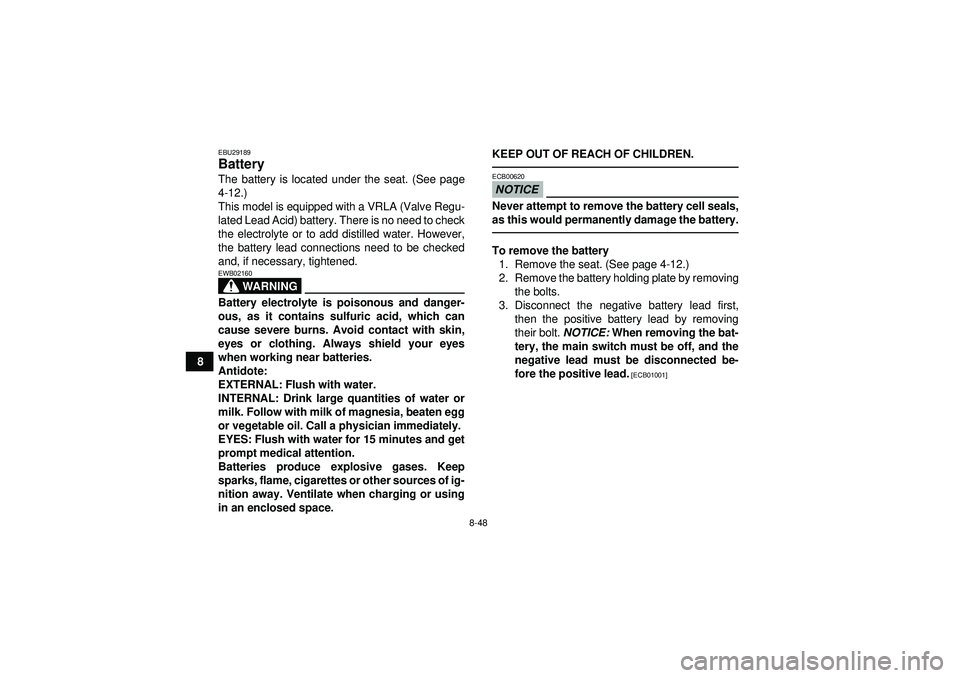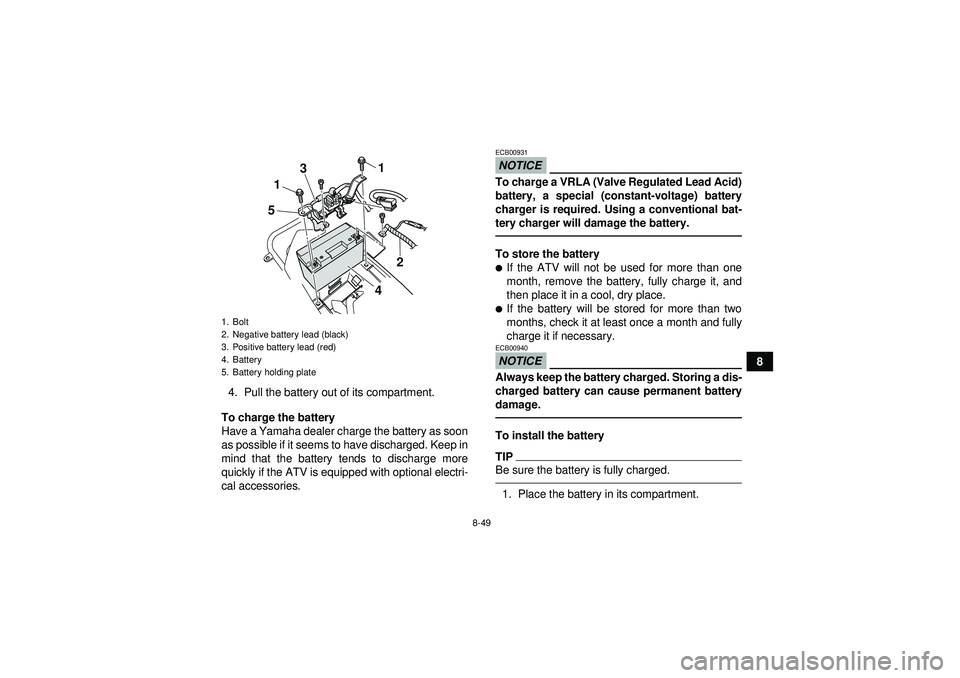Page 10 of 152

Checking the wheel hub bearings ............ 8-45
Lubricating the swingarm pivots ............... 8-46
Lubricating the upper and lower arm pivots ...................................................... 8-46
Lubricating the steering shaft ................... 8-47
Battery ...................................................... 8-48
Replacing the fuse ................................... 8-50
Replacing a headlight bulb ....................... 8-51
Adjusting a headlight beam ...................... 8-53
Replacing the tail/brake light bulb ............ 8-53
Removing a wheel .................................... 8-54
Installing a wheel ...................................... 8-55
Troubleshooting ....................................... 8-55
Troubleshooting charts ............................. 8-57
CLEANING AND STORAGE .......................... 9-1 Cleaning ..................................................... 9-1
Storage ....................................................... 9-2
SPECIFICATIONS ...................................... 10-1
CONSUMER INFORMATION ...................... 11-1 Identification numbers .............................. 11-1
U1PD60E0.book Page 3 Monday, June 13, 2011 2:57 PM
Page 28 of 152

4-3
4
EBU18061Handlebar switches EBU18080Engine stop switch“/”
Set this switch to “” before starting the engine.
The engine stop switch controls the ignition and
stops the engine when it is running. Use this switch
to stop the engine in an emergency situation. The
engine will not start or run when this switch is set
to “” .
EBU18101Start switch “”
Push this switch to crank the engine with the start-
er. See the starting instructions on page 6-1 prior
to starting the engine.EBU18154Light switch “//OFF ”
Set this switch to “” to turn on the low beams
and the taillight. Set the switch to “” to turn on
the high beams and the taillight. Set the switch to
“ OFF ” to turn off all the lights.NOTICEECB00043Do not use the headlights with the engine
turned off for an extended period of time, oth-
erwise the battery may discharge to the point
that the starter motor will not operate properly.
If this should happen, remove the battery and
recharge it. (See page 8-48.)EBU18282Throttle lever Once the engine is running, pushing the throttle le-
ver will increase the engine speed.
1. Light switch “/ /OFF”
2. Engine stop switch “/”
3. Start switch “”
1
23
U1PD60E0.book Page 3 Monday, June 13, 2011 2:57 PM
Page 51 of 152

6-2
6
Ambient temp./starter (choke) position
6. Completely close the throttle lever and start the engine by pushing the start switch.
TIPIf the engine fails to start, release the start switch,
then push it again. Pause a few seconds before
the next attempt. Each cranking should be as short as possible to preserve battery energy. Do not
crank the engine more than 10 seconds on each
attempt.
7. If the engine is started with the starter (choke)
in position (1), the starter (choke) should be
returned to position (2) to warm up the engine.
If the engine is started with the starter (choke)
in position (2), keep the starter (choke) in this
position to warm up the engine.
8. Continue warming up the engine until it idles smoothly, then return the starter (choke) to
position (3) before riding.TIPThe engine is warm when it responds quickly to the
throttle with the starter (choke) turned off.NOTICEECB00163For maximum engine life, never accelerate
hard when the engine is cold!
1. Fully open
2. Half open
3. Closed
4. Starter (choke)
1 2 3
12
3
4
U1PD60E0.book Page 2 Monday, June 13, 2011 2:57 PM
Page 128 of 152

8-48
8
EBU29189Battery The battery is located under the seat. (See page
4-12.)
This model is equipped with a VRLA (Valve Regu-
lated Lead Acid) battery. There is no need to check
the electrolyte or to add distilled water. However,
the battery lead connections need to be checked
and, if necessary, tightened.
WARNING
EWB02160Battery electrolyte is poisonous and danger-
ous, as it contains sulfuric acid, which can
cause severe burns. Avoid contact with skin,
eyes or clothing. Always shield your eyes
when working near batteries.
Antidote:
EXTERNAL: Flush with water.
INTERNAL: Drink large quantities of water or
milk. Follow with milk of magnesia, beaten egg
or vegetable oil. Call a physician immediately.
EYES: Flush with water for 15 minutes and get
prompt medical attention.
Batteries produce explosive gases. Keep
sparks, flame, cigarettes or other sources of ig-
nition away. Ventilate when charging or using
in an enclosed space.KEEP OUT OF REACH OF CHILDREN.
NOTICEECB00620Never attempt to remove the battery cell seals,
as this would permanently damage the battery.To remove the battery
1. Remove the seat. (See page 4-12.)
2. Remove the battery holding plate by removing the bolts.
3. Disconnect the negative battery lead first, then the positive battery lead by removing
their bolt. NOTICE: When removing the bat-
tery, the main switch must be off, and the
negative lead must be disconnected be-
fore the positive lead.
[ECB01001]
U1PD60E0.book Page 48 Monday, June 13, 2011 2:57 PM
Page 129 of 152

8-49
8
4. Pull the battery out of its compartment.
To charge the battery
Have a Yamaha dealer charge the battery as soon
as possible if it seems to have discharged. Keep in
mind that the battery tends to discharge more
quickly if the ATV is equipped with optional electri-
cal accessories.
NOTICEECB00931To charge a VRLA (Valve Regulated Lead Acid)
battery, a special (constant-voltage) battery
charger is required. Using a conventional bat-
tery charger will damage the battery.To store the battery�If the ATV will not be used for more than one
month, remove the battery, fully charge it, and
then place it in a cool, dry place.�If the battery will be stored for more than two
months, check it at least once a month and fully
charge it if necessary.NOTICEECB00940Always keep the battery charged. Storing a dis-
charged battery can cause permanent battery
damage.To install the batteryTIPBe sure the battery is fully charged.1. Place the battery in its compartment.
1. Bolt
2. Negative battery lead (black)
3. Positive battery lead (red)
4. Battery
5. Battery holding plate
1
1
5
2
3
4
U1PD60E0.book Page 49 Monday, June 13, 2011 2:57 PM
Page 130 of 152
8-50
82. Connect the positive battery lead first, then
connect the negative battery lead by installing
their bolt. NOTICE: When installing the bat-
tery, the main switch must be off, and the
positive lead must be connected before
the negative lead.
[ECB01110]
3. Install the battery holding plate by installing the bolts.
4. Install the seat. (See page 4-12.)
EBU25243Replacing the fuse The fuse holder is located under the seat. (See
page 4-12.)
If the fuse is blown, replace it as follows. 1. Turn the key to “OFF ” and turn off all electrical
circuits.NOTICEECB00640To prevent accidental short-circuiting, turn off
the main switch when checking or replacing a
fuse.
1. Negative battery lead (black)
2. Positive battery lead (red)
2
1
1. Fuse
2. Spare fuse
1
2
U1PD60E0.book Page 50 Monday, June 13, 2011 2:57 PM
Page 137 of 152

8-57
8
EBU25784Troubleshooting charts Starting problems or poor engine performance
Check the fuel level in
the fuel tank.1. Fuel
There is enough fuel.There is no fuel.
Check the compression.
Supply fuel.
The engine does not start.
Check the compression.
Operate the electric starter.2. Compression
There is compression.
There is no compression.
Check the ignition. Have a Yamaha dealer
check the ATV.
Remove the spark plug
and check the electrodes.3. Ignition
Wipe off with a dry cloth and correct the
spark plug gap, or replace the spark plug.
Have a Yamaha dealer check the ATV.
The engine does not start.
Have a Yamaha dealer
check the ATV.
The engine does not start.
Check the battery.
Operate the electric starter.4. Battery
The engine turns over
quickly.
The engine turns over
slowly.
The battery is good.Check the battery lead connections,
and have a Yamaha dealer charge
the battery if necessary.
DryWet
Open the throttle halfway and operate
the electric starter.
U1PD60E0.book Page 57 Monday, June 13, 2011 2:57 PM
Page 141 of 152
9-3
9
ly, turn the wheels a little every month in order
to prevent the tires from becoming degraded
in one spot.
8. Cover the muffler outlet with a plastic bag to prevent moisture from entering it.
9. Remove the battery and fully charge it. Store it in a cool, dry place and charge it once a
month. Do not store the battery in an exces-
sively cold or warm place [less than 0 ° C (30
° F) or more than 30 ° C (90 °F)]. For more in-
formation on storing the battery, see page
8-48.
TIPMake any necessary repairs before storing the
ATV.U1PD60E0.book Page 3 Monday, June 13, 2011 2:57 PM